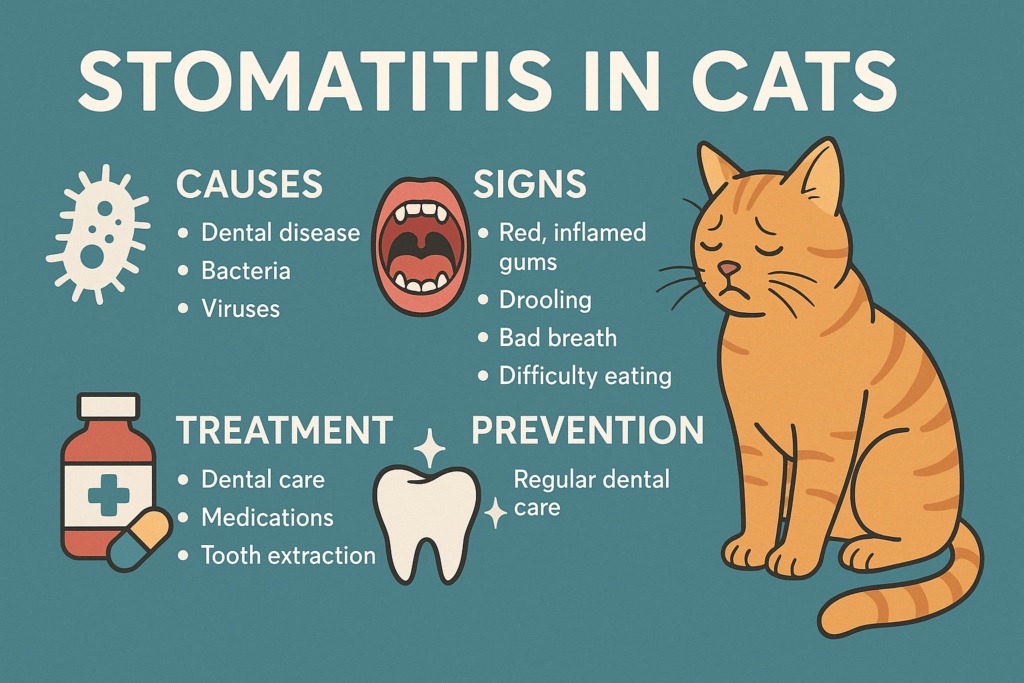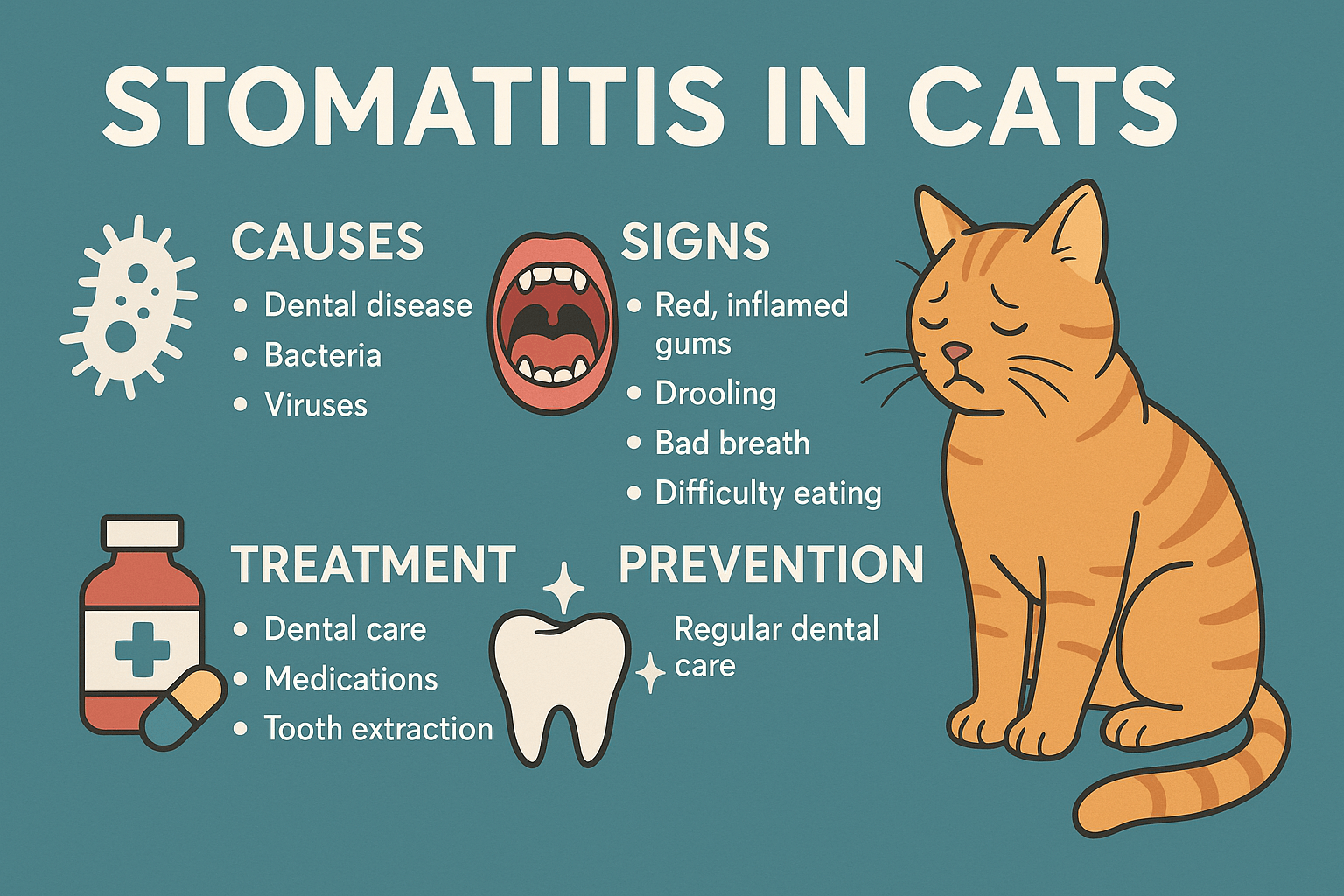Understanding Stomatitis in Cats
Stomatitis in cats is a painful and often debilitating oral condition that affects their gums, mouth lining, and overall quality of life. This inflammatory disease can make eating, grooming, and even resting a challenge for your feline companion. While the exact cause of stomatitis remains unclear, it’s believed to involve an abnormal immune response to plaque bacteria. Recognizing the symptoms early and seeking veterinary care promptly can significantly improve your cat’s comfort and prognosis. In this blog post, we’ll explore everything you need to know about stomatitis in cats—from its causes and symptoms to treatment options and long-term management strategies.
Expert Insight on Stomatitis in Cats
“Stomatitis in cats is a complex, painful, and frustrating disease that causes severe inflammation of the entire mouth, including the gingiva (gum tissue around the teeth) and mucous membranes.”
Common Symptoms of Stomatitis in Cats
Identifying the signs of stomatitis early is crucial for ensuring timely intervention and treatment. Here are some common symptoms that indicate your cat may be suffering from this painful condition.
Excessive Drooling:
Cats with stomatitis often drool excessively due to the discomfort and inflammation in their mouths.Difficulty Eating or Loss of Appetite:
Pain while chewing can lead to reduced food intake or complete refusal to eat, resulting in weight loss.Bad Breath (Halitosis):
Foul-smelling breath is a telltale sign of oral infections or inflammation caused by stomatitis.Swollen or Bleeding Gums:
The gums may appear red, swollen, or bleed easily when touched or during brushing.Behavioral Changes:
Cats may become irritable, withdrawn, or show signs of pain, such as pawing at their mouth or avoiding interaction.
If you notice any of these symptoms, consult your veterinarian immediately to determine the underlying cause and begin appropriate treatment.

Potential Causes and Risk Factors for Stomatitis
While the exact cause of stomatitis in cats remains unknown, several factors are believed to contribute to its development. Understanding these triggers can help you take preventive measures and reduce your cat’s risk.
Immune System Dysfunction:
An overactive immune response to plaque bacteria is thought to play a significant role in the onset of stomatitis.Viral Infections:
Diseases like feline calicivirus or feline immunodeficiency virus (FIV) may increase susceptibility to oral inflammation.Genetic Predisposition:
Certain breeds, such as Siamese and Himalayans, are more prone to developing stomatitis than others.Poor Oral Hygiene:
Lack of regular dental care can lead to plaque buildup, worsening the severity of stomatitis symptoms.Chronic Stress or Illness:
Stress or underlying health conditions can weaken the immune system, making cats more vulnerable to stomatitis.
By addressing these potential causes, you can minimize your cat’s risk of developing this painful condition.
Check this guide 👉Hyperthermia in Cats: Best 7 Expert Tips!
Check this guide 👉Pectoantebrachialis Muscle in Cats: Best 7 Expert Tips!
Check this guide 👉Understanding Cat Mouth Cysts: Best 7 Expert Tips!
Preventive Measures for Stomatitis | Treatment Options Available |
|---|---|
Regular dental cleanings | Professional teeth cleaning under anesthesia |
Daily tooth brushing | Antibiotics to reduce infection |
Providing a balanced diet | Anti-inflammatory medications |
Routine vet check-ups | Full-mouth extractions in severe cases |
Minimizing stress | Pain management therapies |
Diagnosis Process for Stomatitis in Cats
Diagnosing stomatitis involves a thorough evaluation by a veterinarian to rule out other potential causes of oral inflammation. Understanding the diagnostic process can help you prepare for your cat’s appointment.
Physical Examination:
Your vet will visually inspect your cat’s mouth for signs of inflammation, swelling, or ulcers.Medical History Review:
Providing details about your cat’s symptoms, behavior changes, and diet helps the vet make an informed assessment.Dental X-rays:
X-rays may be taken to evaluate the extent of damage to the teeth and surrounding tissues.Blood Tests:
Blood work can identify underlying conditions, such as viral infections, that may contribute to stomatitis.Biopsy (if necessary):
In rare cases, a tissue sample may be collected to confirm the diagnosis and rule out cancer or other diseases.
A comprehensive diagnosis ensures that your cat receives the most appropriate and effective treatment plan.
Long-Term Management Strategies for Stomatitis
Managing stomatitis requires ongoing care and commitment to ensure your cat’s comfort and well-being. These strategies can help you maintain their oral health and quality of life.
Regular Dental Check-Ups:
Schedule routine visits to monitor your cat’s oral health and address any emerging issues promptly.Pain Management:
Work with your vet to develop a pain relief plan, especially if full-mouth extractions are not an option.Soft Food Diet:
Feeding soft, high-quality food reduces discomfort while eating and prevents further irritation.Oral Hygiene Routine:
Continue brushing your cat’s teeth (if possible) or use dental wipes to keep their mouth clean.Stress Reduction Techniques:
Create a calm environment with plenty of enrichment activities to support your cat’s overall health.
With consistent care and attention, you can help your cat live comfortably despite their condition.
Tips for Reducing Oral Pain
Managing oral pain is essential for improving your cat’s quality of life while dealing with stomatitis. These tips can help alleviate discomfort and promote healing.
Administer Medications as Prescribed:
Follow your vet’s instructions carefully when giving pain relievers or anti-inflammatory drugs.Offer Cooling Treats:
Frozen treats or ice cubes can soothe inflamed gums and provide temporary relief.Avoid Hard Foods and Toys:
Hard objects can irritate the mouth further; opt for softer alternatives instead.Use Therapeutic Mouthwashes:
Specialized rinses recommended by your vet can reduce bacteria and inflammation.Monitor for Side Effects:
Keep an eye on any adverse reactions to medications or treatments and report them to your vet.
Implementing these strategies can help ease your cat’s discomfort and speed up recovery.
Signs Your Cat Is Improving
Tracking progress is important to gauge the effectiveness of your cat’s treatment plan. Look for these positive signs that indicate improvement.
Increased Appetite:
A return to normal eating habits suggests reduced pain and improved oral health.Less Drooling:
Decreased drooling indicates that inflammation is subsiding.Improved Energy Levels:
Cats showing renewed interest in play or exploration may be feeling better.Cleaner Breath:
Fresher breath often reflects a reduction in oral bacteria and infection.Reduced Pawing at the Mouth:
Less frequent pawing or rubbing of the face signals decreased discomfort.
Recognizing these improvements reassures you that your efforts are paying off and your cat is on the path to recovery.
Emotional Support for Your Cat
Cats with stomatitis may experience emotional distress due to chronic pain and discomfort. Offering emotional support strengthens your bond and aids in their healing journey.
Provide a Safe Space:
Create a quiet, cozy area where your cat can retreat and relax without disturbances.Engage in Gentle Play:
Use interactive toys to distract and entertain your cat without causing physical strain.Stick to Routines:
Maintaining a predictable schedule reduces stress and provides a sense of security.Offer Comfort Items:
Familiar blankets or bedding can provide warmth and reassurance during tough times.Spend Quality Time Together:
Simply being present and offering affection reminds your cat they are loved and cared for.
Emotional support complements medical treatment, helping your cat cope with the challenges of stomatitis.
Frequently Asked Questions About Stomatitis in Cats
Can stomatitis in cats be cured?
While there is no definitive cure, treatments like full-mouth extractions can significantly improve symptoms and quality of life.
Is stomatitis painful for cats?
Yes, stomatitis causes severe pain, which can affect eating, grooming, and daily activities.
How much does treatment cost?
Costs vary depending on the severity of the condition but may include expenses for exams, medications, and surgeries.
Can I prevent stomatitis in my cat?
While not always preventable, good oral hygiene and regular vet visits can reduce the risk.
What should I feed my cat with stomatitis?
Soft, wet food is easier for cats with stomatitis to eat and minimizes irritation to inflamed tissues.
Supporting Your Cat Through Stomatitis
Stomatitis in cats is a challenging condition that requires patience, dedication, and collaboration with your veterinarian. By staying informed about its causes, symptoms, and treatment options, you can provide the best possible care for your feline friend. Remember, early detection and proactive management are key to improving your cat’s comfort and overall well-being. With love, attention, and proper medical support, you can help your cat navigate this difficult condition and enjoy a happy, fulfilling life.
Canned Pumpkin for Cat Diarrhea: Best 7 Expert Tips! Natural remedy to firm stools, soothe upset bellies, and support gut health safely.
Can a Cat Give You Scabies? Best 7 Expert Tips! Discover the truth about feline mites, human skin risks, and how to protect yourself—without panic.
Cat Flea vs Human Flea: Best 7 Expert Tips! Discover the truth about bites, species, and how to eliminate infestations for good.
Weird Cat Behaviors: Best 7 Expert Tips! Discover why cats do strange things—and how to understand, not punish, their instincts for a happier home.





